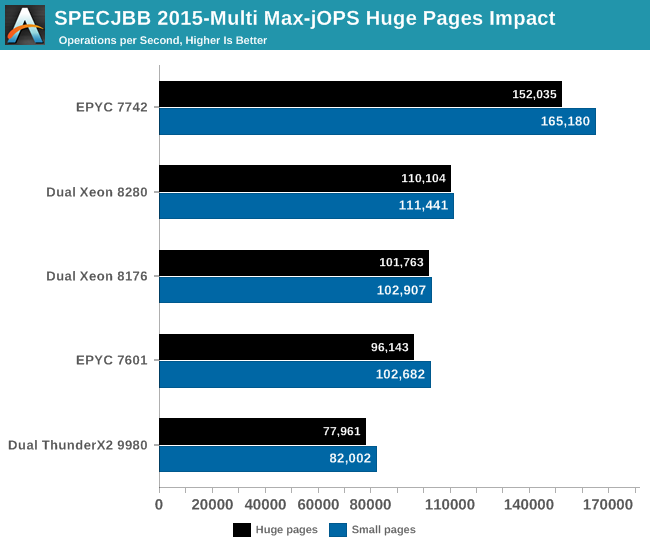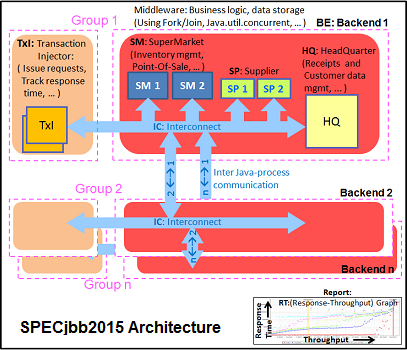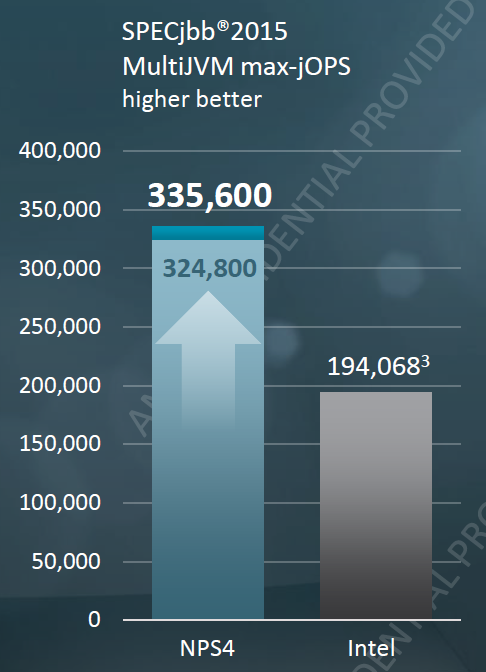AMD Rome Second Generation EPYC Review: 2x 64-core Benchmarked
by Johan De Gelas on August 7, 2019 7:00 PM ESTJava Performance
The SPECjbb 2015 benchmark has 'a usage model based on a world-wide supermarket company with an IT infrastructure that handles a mix of point-of-sale requests, online purchases, and data-mining operations'. It uses the latest Java 7 features and makes use of XML, compressed communication, and messaging with security.
We test SPECjbb with four groups of transaction injectors and backends. The reason why we use the "Multi JVM" test is that it is more realistic: multiple VMs on a server is a very common practice.
The Java version was OpenJDK 1.8.0_222. We used the older JDK 8 as the most recent JDK 11 has removed some deprecated JAVA EE modules that SPECJBB 1.01 needs. We applied relatively basic tuning to mimic real-world use, while aiming to fit everything inside a server with 128 GB of RAM:
We tested with huge pages on and off.
The graph below shows the maximum throughput numbers for our MultiJVM SPECJbb test. Since the test is almost identical to the one that we have used in our ThunderX2 review (JDK8 1.8.0_166), we also include Cavium's server CPU.
Ultimately we publish these numbers with a caveat: you should not compare this with the official published SPECJBB2015 numbers, because we run our test slightly differently to the official run specifications. We believe our numbers make as much sense (and maybe more) as most professionals users will not go for the last drop of performance. Using these ultra optimized settings can result in unrepeateable and hard to debug inconsistent errors - at best they will result in subpar performance as they are so very specific to SPECJBB. It is simply not worth it, a professional will stick with basic and reliable optimization in the real non-HPC world. In the HPC world, you simply rerun your job in case of an error. But in the rest of the enterprise world you just made a lot users very unhappy and created a lot of work for (hopefully) well paid employees.

The EPYC 7742 performance is excellent, outperforming the best available Intel Xeon by 48%.
Notice that the EPYC CPU performs better with small pages (4 KB) than with large ones (2 MB). AMD's small pages TLB are massive and as result page table walks (PTW) are seldom with large pages. If the number of PTW is already very low, you can not get much benefit from increasing the page size.
What about Cavium? Well, the 32-core ThunderX2 was baked with a 16 nm process technology. So do not discount them - Cavium has a unique opportunity as they move the the ThunderX3 to 7 nm FFN TSMC too.
To be fair to AMD, we can improve performance even higher by using numactl and binding the JVM to certain CPUs. However, you rarely want to that, and happily trade that extra performance for the flexibility of being able to start new JVMs when you need them and let the server deal with it. That is why you buy those servers with massive core counts. We are in the world of micro services, docker containers, not in the early years of 21st century.
Ok, what if you do that anyway? AMD offered some numbers, while comparing them to the officialy published SPEJBB numbers of Lenovo ThinkSystem SR650 (Dual Intel 8280).
AMD achieves 335600 by using 4 JVM per node, binding them to "virtual NUMA nodes".
Just like Intel, AMD uses the Oracle JDK, but there is more to these record breaking numbers. A few tricks that only benchmarking people can use to boost SPECJBB:
- Disabling p-states and setting the OS to maximum performance (instead of balanced)
- Disabling memory protection (patrol scrub)
- Using older garbage collector because they happen to better at Specjbb
- Non-default kernel settings
- Aggressive java optimizations
- Disabling JVM statistics and monitoring
- ...
In summary, we don't think that it is wise to mimic these settings, but let us say that AMD's new EPYC 7742 is anywhere between 48 and 72% faster. And in both cases, that is significant!












180 Comments
View All Comments
JoeBraga - Wednesday, August 14, 2019 - link
It can happen if Intel uses the new archtecture Sunny Cove and MCM/Chiplet design instead of Monolithic DesignSanX - Thursday, August 15, 2019 - link
7zip is not a legacy test, it is important for anyone who sends big data over always damn slow network. Do you know all those ZIPs, GZs and other zippers which people mostly use, compress with turtle speeds as low as 20 MB/s even on supercomputers ? The 7Zip though parallelizes that nicely. So do not diminish this good test calling it "legacy"imaskar - Friday, August 16, 2019 - link
7zip is a particular program, doing LZMA in parallel, that's why it is faster that lets say gzip. But on server you often do not want to parallel things, because other cores are doing other jobs and switching is costly. There are a lot of compressing algorithms which are better in certain situations. LZMA rarely fits. More often it is it's LZ4 or zstd for "generate once, consume many" or basic gzip (DEFLATE) for "generate once, consume once". Yes, you would be surprised, but the very basic 30 years old DEFLATE is still the king if you care for sum of compress, send, decompress AND your nodes are inside one datacenter (which is most of the times).SanX - Thursday, August 15, 2019 - link
What you can say about Ian's own test he developed to demonstrate avx512 speed boost which shows some crazy up to 3-4x or more speedups ? Does your test of Molecular Dynamics tell that Ian's test mostly irrelevant for such huge improvement of speed of the real life complex programs?imaskar - Friday, August 16, 2019 - link
Probably because you can't use ONLY avx512. You still need regular things like jumps and conditions. And this is only the best case. Usually you also need to process part of the vector differently. For example, your vector has size 20, but your width is 16. You either do another vector pass, or 4 regular computations. Often second thing is faster or just the only option.realbabilu - Sunday, August 18, 2019 - link
Most of finite element software use Intel mkl to get every juice power spec of processor.it works for Intel ones not for amdAmd math kernel not heavily programmed, otnwaa just for Linux.
Other third party like gotoblas openblas still trying hard to detect cache and type for zen2.
I mean for workstation floating point still hard for amd.
peevee - Monday, August 19, 2019 - link
Prices per core-GHz:EPYC 7742 $48.26
EPYC 7702 $50.39
EPYC 7642 $43.25
EPYC 7552 $38.12
EPYC 7542 $36.64
EPYC 7502 $32.50
EPYC 7452 $26.93
EPYC 7402 $26.53
EPYC 7352 $24.46
EPYC 7302 $20.38
EPYC 7282 $14.51
EPYC 7272 $17.96
EPYC 7262 $22.46
EPYC 7252 $19.15
Value in this 7282 is INSANE.
peevee - Tuesday, August 20, 2019 - link
"Even though our testing is not the ideal case for AMD (you would probably choose 8 or even 16 back-ends), the EPYC edges out the Xeon 8176. Using 8 JVMs increases the gap from 1% to 4-5%."1%? 36917 / 27716 = 1.3319...
33%. Without 8 JVMs.
KathyMilligan - Wednesday, August 21, 2019 - link
University of Illinois Urbana-Champaign is very good university. I am too poorly prepared for this level of education. But I'm getting ready. I read a lot of articles and books, communicate with many smart former students of this university. I also buy research papers on site and this gives me a lot of useful information, which is not so easy to find on the Internet.YB1064 - Wednesday, August 28, 2019 - link
Looks like Intel has been outclassed, out-priced and completely out-maneuvered by AMD. What a disaster!